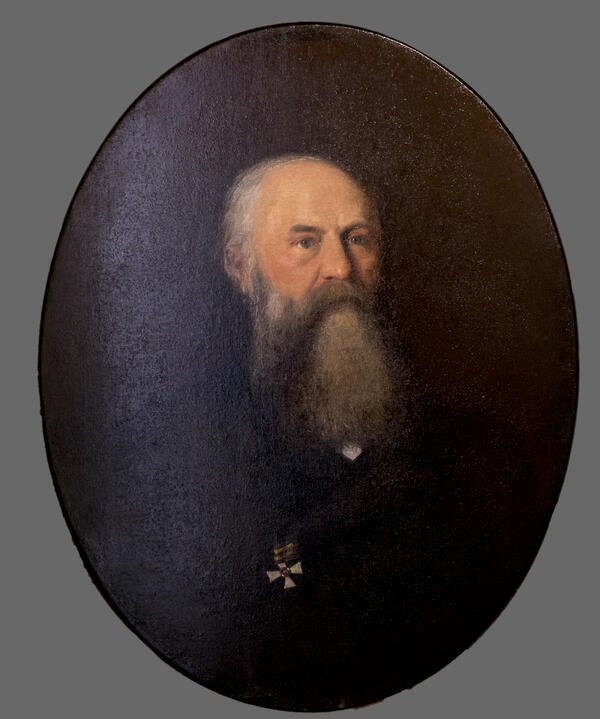Urusov Sergey Semenovich (1827–1897) was a Major General, mathematician, outstanding amateur chess player. He came from the Yaroslavl ramage of the Urusovs princely family. He was an officer in the Russian army and took part in the Crimean War of 1853-1856. In Sevastopol, he defended the fourth bastion, which was considered the most dangerous. During the defense of Sevastopol, he met the writer Leo Nikolaevich Tolstoy.
Their friendship lasted for a very long time. After the end of combat activities, the writer often visited Urusov in the village of Spas-Torbeevo near the Laura of the Holy Trinity and St. Sergius. Sergey Semenovich became the godfather of Tolstoy’s children - Leo, Maria and Peter, who died early enough.
For Urusov, chess was more than entertainment. There are two interesting cases that describe his passion for this game.
The first was described by Leo Tolstoy in his letter to the “Swedish Peace Fighters”. During the siege of Sevastopol, he was with the adjutant Dmitry Osten-Saken just when Urusov entered the reception room. He stated that he had a question for the general. What happened next, Tolstoy described as follows: “Ten minutes later Urusov walked past us with a displeased face. The adjutant who saw him off came back to us and, laughing, told us about what business Urusov had come to Saken for. He came to propose a challenge to the British to play a game of chess in the front trench in the face of the 5th bastion, which changed hands several times and cost hundreds of lives”.
The second incident occurred during the bombarding, when Sergey Semenovich played a game for three. During the game, Urusov never even glanced at the board - one or another move was announced by voice. The scenery of this game was well conveyed by the participant of the Crimean War, Prince Vladimir Ivanovich Baryatinsky: “It should be noted that during all this time those present were exposed to rather great danger, because Congreve rockets launched from British batteries at Inkerman Heights every evening were directed to the point where we were <…> Urusov continued his triple play calmly, taking sips from a glass of tea… " As a result, Urusov won two games out of three, and the game itself ended well after midnight.
In the early 1850s, Urusov played with the best chess players of that era and in Russia was second only to Alexander Petrov, to whom he lost twice. In 1878, the prince ended his chess career.
The portrait kept in the Zaraysk museum collection is by the Itinerant artist Rafail Sergeevich Levitsky (1844–1930).
Their friendship lasted for a very long time. After the end of combat activities, the writer often visited Urusov in the village of Spas-Torbeevo near the Laura of the Holy Trinity and St. Sergius. Sergey Semenovich became the godfather of Tolstoy’s children - Leo, Maria and Peter, who died early enough.
For Urusov, chess was more than entertainment. There are two interesting cases that describe his passion for this game.
The first was described by Leo Tolstoy in his letter to the “Swedish Peace Fighters”. During the siege of Sevastopol, he was with the adjutant Dmitry Osten-Saken just when Urusov entered the reception room. He stated that he had a question for the general. What happened next, Tolstoy described as follows: “Ten minutes later Urusov walked past us with a displeased face. The adjutant who saw him off came back to us and, laughing, told us about what business Urusov had come to Saken for. He came to propose a challenge to the British to play a game of chess in the front trench in the face of the 5th bastion, which changed hands several times and cost hundreds of lives”.
The second incident occurred during the bombarding, when Sergey Semenovich played a game for three. During the game, Urusov never even glanced at the board - one or another move was announced by voice. The scenery of this game was well conveyed by the participant of the Crimean War, Prince Vladimir Ivanovich Baryatinsky: “It should be noted that during all this time those present were exposed to rather great danger, because Congreve rockets launched from British batteries at Inkerman Heights every evening were directed to the point where we were <…> Urusov continued his triple play calmly, taking sips from a glass of tea… " As a result, Urusov won two games out of three, and the game itself ended well after midnight.
In the early 1850s, Urusov played with the best chess players of that era and in Russia was second only to Alexander Petrov, to whom he lost twice. In 1878, the prince ended his chess career.
The portrait kept in the Zaraysk museum collection is by the Itinerant artist Rafail Sergeevich Levitsky (1844–1930).



